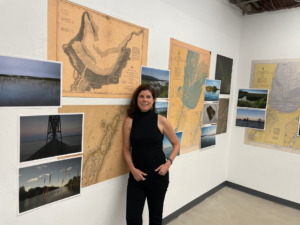By Janelle Fisher, City Pages Editor
A new pop-up exhibit will open at newArtSpace in De Pere on Friday, Aug. 4, featuring artwork by photographer Collette LaRue designed to prompt viewers to reflect on the waters surrounding the area and the impact humans have had on them.
“It’s called Watermarks,” LaRue said. “It’s a double reference to how images are marked so people know that they’re copyrighted… and the name is a reflection of the human imprint on the Green Bay estuary.”
The project, LaRue said, was not only made possible but also inspired by an award she was granted, named for Jerry Dell, former UW-Green Bay professor, photographer and artist.
“This project stemmed from a scholarship award I received at UW-Green Bay,” she said. “It’s called the Jerry Dell? Award. The specific focus of the award was capturing the human imprint on the Green Bay estuary. I was a student at UW-Green Bay for years studying photography and, in that time, I earned several other awards. I started studying the estuary and I learned that it’s the largest freshwater estuary in the world.”
When she started working on the exhibit, LaRue said the significance of Green Bay’s National Estuarine Reserve System was something she knew she wanted to focus on.
“I thought it was just amazing that we live on the shores of this amazing, estuarine resource,” she said. “I wanted to celebrate that. So I started into this project trying to think about how to approach this, because we all know about the negative things that have happened, but our human impact’s also now a lot of preservation and conservation… Our human imprint has been positive, so it’s a story of the human impact having an influence and direction.”
To tell that story, LaRue said she has incorporated historical artifacts related to the areas she photographed.
“What I’ve done is I’ve worked with the Cofrin Archives and the library archivist and pulled up some vintage maps and artifacts and I’m pairing them with images that I took from 2020 to 2023, just to kind of juxtapose the history with the present,” she said.
The history and present state of the estuary and surrounding areas is something LaRue said she didn’t know much about until she started studying photography at UW-Green Bay.
“I was a marketing/communications professional for years and after our four children graduated and moved out of the house, I started studying photography and Spanish and I really enjoyed both of them,” she said. “I study at UW-Green Bay, which gives me so many opportunities… Until I started actually studying the estuary, I really had no idea of the impact that UW-Green Bay and Uw-Madison and UW-Milwaukee had on the preservation. That affects every person in the community.”

Despite affecting the community, LaRue said the value of the estuary and the university’s role in preserving it is something many members of the community — herself included — do not fully realize.
“I live right on the shores of the bay,” she said. “I live right there, and the whole time, I thought I understood it. But the deeper I get into this, the more I understand how important the UW-System is to the preservation and reclamation of the water.”
With her exhibit, LaRue said she hopes to share that importance with the community and show viewers the importance of the areas she has photographed.
“What struck me is everyone thinks of Green Bay and they think of the Packers, which is super fun and it’s something that brings the community together and that’s a very positive thing, but we also have this estuary that’s a natural resource and that brings people together, too,” she said. “I’d like to see more people using it and more people understanding it. I want the younger people to be exposed to it and understand its treasure. They will be the guardians, the directors moving it into the future.”
If people could take only one thing away from her exhibit, LaRue said she hopes it would be an increased appreciation for the beauty and significance of the natural resource which residents of the greater Green Bay area have access to.
“Green Bay sits on the shores of the largest freshwater estuary in the world,” she said. “The Great Lakes comprise something like 23% of all of the freshwater in the world, and in a time of extreme climate change and water shortages across the United States and world, we are so extremely fortunate to have this resource right at our shores. That’s what I want people to know — how the Green Bay is really our identity and we have this amazing resource.”
LaRue’s exhibit will open at newArtSpace on Thursday, Aug. 4, from 4-8 p.m. and will remain at the gallery through Aug. 15.
More information about Watermarks can be found at newartspace124.com/exhibitions/watermarks. Additional details about the National Estuarine Reserve System can be found at uwgb.edu/national-estuarine-research-reserves.

